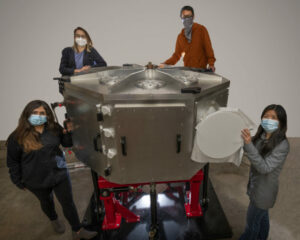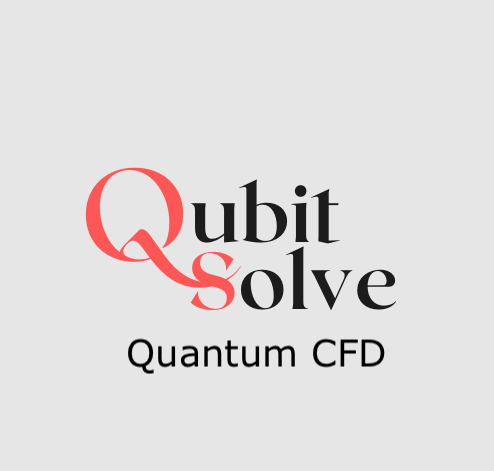
Achieving the immense promise of quantum computing requires new developments at every level, including the computing hardware itself. A Lawrence Berkeley National Laboratory (Berkeley Lab)-led international team of researchers has discovered a way to use ion beams to create long strings of “color center” qubits in diamond. Their work is detailed in the journal Applied Physics Letters.
Creating large numbers of high-quality quantum bits (qubits), in close enough proximity for coupling to each other, is one of the great challenges of quantum computing. Collaborating with colleagues worldwide, the team has been exploring the use of ion beams to create artificial color centers in diamond for use as qubits.
Color centers are microscopic defects – departures from the rigorous lattice structure of a crystal, such as diamond. The type of defect that is of specific interest for qubits is a nitrogen atom next to a vacancy, or empty space, in a diamond lattice. (Nitrogen is commonly found in the crystal lattice of diamond, which is primarily a crystalline form of carbon, and can contribute to the color of the stone.)

When excited by the rapid energy deposition of a passing ion, nitrogen-vacancy centers can form in the diamond lattice. The electron and nuclear spins of nitrogen-vacancy centers and the adjacent carbon atoms can all function as solid-state qubits, and the crystal lattice can help protect their coherence and mutual entanglement.

The result is a physically durable system that does not have to be used in a cryogenic environment, which are attractive attributes for quantum sensors and also for qubits in this type of solid-state quantum computer. However, making enough qubits, and making them close enough to each other, has been a challenge.
When swift (high-energy) heavy ions such as the beams this team used – gold ions with a kinetic energy of about one billion electron volts – pass through a material, such as nitrogen-doped diamond, they leave a trail of nitrogen-vacancy centers along their tracks. Color centers were found to form directly, without need for further annealing (heat treatment). What’s more, they formed all along the ion tracks, rather than only at the end of the ion range as had been expected from earlier studies with lower-energy ions. In these straight “percolation chains,” color-center qubits are aligned over distances of tens of microns, and are just a few nanometers from their nearest neighbors. A technique developed by Berkeley Lab’s Molecular Foundry measured color centers with depth resolution.
The work on qubit synthesis far from equilibrium was supported by the Department of Energy’s Office of Science. The next step in the research will be to physically cut out a group of these color centers – which are like a series of beads on a string – and show that they are indeed so closely coupled that they can be used as quantum registers.
Results published in the current article show that it will be possible to form quantum registers with up to about 10,000 coupled qubits – two orders of magnitude greater than achieved thus far with the complementary technology of ion-trap qubits – over a distance of about 50 microns (about the width of a human hair).
“Interactions of swift heavy ions with materials have been studied for decades for a variety of purposes, including the behavior of nuclear materials and the effects of cosmic rays on electronics,” said Schenkel.
He added that researchers worldwide have sought to make quantum materials by artificially inducing color centers in diamond. “The solid-state approaches to quantum computing hardware scale beautifully, but integration has been a challenge. This is the first time that direct formation of color-center qubits along strings has been observed.”
The stars, like diamonds
On a miniscule and ephemeral scale (nanometers and picoseconds) the deposition of energy by the ion beams produces a state of high temperature, which Schenkel likens to the surface of the sun, in the 5000 K range, and pressure. Besides knocking carbon atoms out of the crystal lattice of diamond, this effect could enable fundamental studies of exotic states of transient warm dense matter, a state of matter that is present in many stars and large planets and which is difficult to study directly on Earth.
It might also enable formation of novel qubits with tailored properties that cannot be formed with conventional methods. “This opens a new direction for expanding our ability to form quantum registers,” said Schenkel.
Currently, color-center strings are formed with beams from large particle accelerators, such as the one at the German laboratory GSI that was used in this research. In the future, they might be made using compact laser-plasma accelerators like the ones being developed at the Berkeley Lab Laser Accelerator (BELLA) Center.
The BELLA Center is actively developing its ion-acceleration capabilities with funding by the DOE Office of Science. These capabilities will be used as part of LaserNetUS. Ion pulses from laser-plasma acceleration are very intense and greatly expand our ability to form transient states of highly excited and hot materials for qubit synthesis under novel conditions.
More facets in materials science far from equilibrium
The process of creating these color centers is interesting in its own right and has to be better understood as part of further progress in these applications. The details of how an intense ion beam deposits energy as it traverses the diamond samples, and the exact mechanism by which this leads to color-center formation, hold exciting prospects for further research.
“This work demonstrates both the discovery science opportunities and the potential for societally transformative innovations enabled by the beams from accelerators,” says ATAP Division Director Cameron Geddes. “With accelerators, we create unique states of matter and new capabilities that are not possible by other means.”
The authors includes several scientists from Berkeley Lab: Arun Persaud, who led the study, and Thomas Schenkel, head of the Accelerator Technology and Applied Physics (ATAP) Division’s Fusion Science & Ion Beam Technology Program, as well as Casey Christian (now with Berkeley Lab’s Physics Division), Edward Barnard of Berkeley Lab’s Molecular Foundry, and ATAP affiliate Russell E. Lake.
For information about licensing or collaboration, contact Berkeley Lab’s Intellectual Property Office at [email protected].
For more market insights, check out our latest quantum computing news here.

















